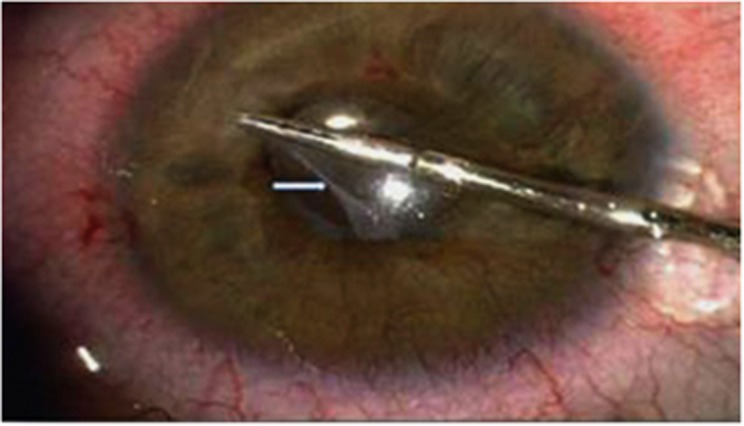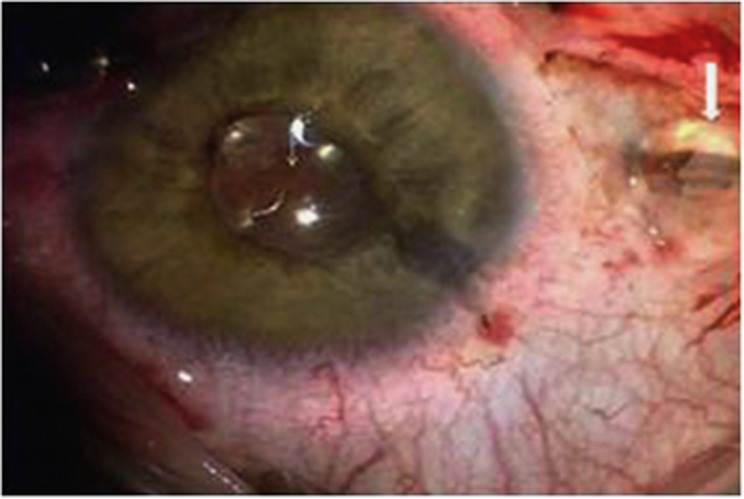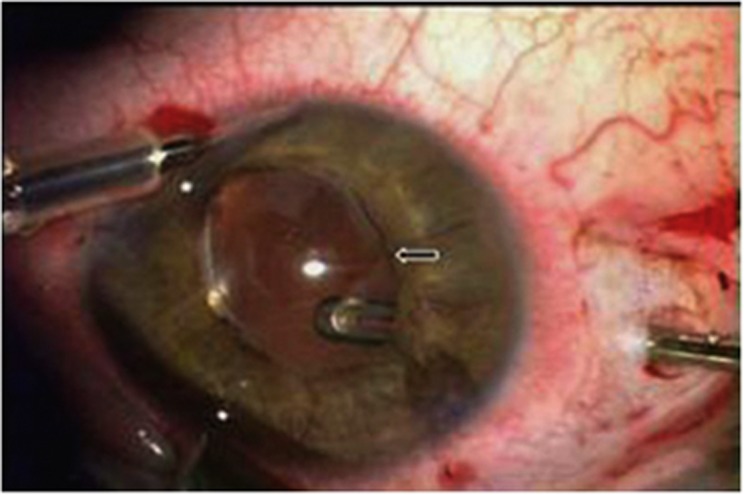Sir,
The case report is from Great Ormond Street Hospital, London, UK. Capsular blockage syndrome (CBS) is a rare complication of cataract surgery. We report a case of 7 year old girl with CBS after lensectomy and PCIOL implantation for uveitic cataract.
Case report
A 7-year-old girl with ANA positive, oligoarticular onset Juvenile idiopathic arthritis (JIA) had left cataract extraction with PCIOL. She had been uveitis free for 2 years having been on methotrexate and systemic steroids (1 mg/kg). She had posterior synechiolysis, TIPP (two-incision push-pull rhexis—a variant of continuous curvilinear capsulorrhexis (CCC))1 anterior and posterior rhexis approximately 5 and 3.5 mm in diameter, respectively, lens aspiration, anterior vitrectomy, in the bag hydrophobic acrylic IOL implantation (MA60AC, Alcon) and a peripheral iridectomy. She was given intracameral preservative-free dexamethasone (0.2 ml of 4 mg/ml), intravitreal and orbital floor triamcinolone and subconjunctival cefuroxime.
Postoperatively she received topical steroid/antibiotic drops and a 6 weeks oral steroid taper. Ocular examination and intraocular pressure (IOP) was normal in the immediate postoperative period. Four months later, she presented with left decreased vision (BCVA 20/200), shallow anterior chamber, a pupillary membrane, and visual axis opacification. The right eye was normal. IOP was 12 mm Hg in both the eyes. Surgical removal of the anterior membrane (Figure 1) had no effect on the anterior chamber depth. However, pars plana posterior membranectomy resulted in rapid egress of the bag contents (clear fluid) with immediate deepening of anterior chamber (Figures 2 and 3). The diagnosis of capsular blockage syndrome (CBS) was made (see Supplementary Video). The patient recovered 20/80 of BCVA after 6 weeks.
Figure 1.
Intra-operative picture showing removal of anterior membrane (white arrow), fixed pupil, and shallow anterior chamber.
Figure 2.
Intra-operative picture showing an incision into a thick membrane in the visual axis. (Thin arrow) and MVR blade is being removed. As MVR is withdrawn, gush of aqueous-like fluid (thick arrow) is seen.
Figure 3.
Intra-operative picture showing deep anterior chamber, dilated pupil with anterior vitrectomy and enlargement of posterior membrane opening.
Comment
CBS is a rare complication of cataract extraction with PCIOL and CCC. A closed chamber forms between the PCIOL and the posterior capsule due to anterior capsule adherence to the PCIOL optic; accumulation of liquefied substance or aqueous in the bag causes posterior capsule distension and bowing of the iris-lens diaphragm mimicking pupillary block.2, 3, 4
To the best of our knowledge, this has not previously been reported in a child. Furthermore, the lack of IOP rise can be explained by the cilliary body dysfunction often seen in cases of JIA-related uveitis.
Treatment options include observation, topical steroids, YAG capsulotomy, slitlamp needle revision, and aspiration of the liquefied substance.3, 5
CBS may be noncellular, inflammatory, or fibrotic;3 our case was a combination of inflammatory and fibrotic. We speculate that the anterior membrane occluded the pupil and peripheral iridectomy. The closed chamber was formed behind the IOL because of the closure of the posterior capsulotomy by the inflammatory membrane.
In conclusion, in pediatric patients post cataract extraction with PCIOL, especially if uveitic, with shallow anterior chamber and retro IOL membrane formation, the possibility of CBS should be considered despite a normal IOP. Preoperative anterior segment OCT or high frequency ultrasound may be helpful in making the diagnosis but this was not available in our case.
The authors declare no conflict of interest.
Footnotes
Supplementary Information accompanies this paper on Eye website (http://www.nature.com/eye)
Supplementary Material
References
- Nischal KK. Two-incision push-pull capsulorhexis for pediatric cataract surgery. J Cataract Refract Surg. 2002;28 (4:593–595. doi: 10.1016/s0886-3350(01)01125-7. [DOI] [PubMed] [Google Scholar]
- Miyake K, Ota I, Ichihashi S, et al. New classification of capsular block syndrome. J Cataract Refract Surg. 1998;24:1230–1234. doi: 10.1016/s0886-3350(98)80017-5. [DOI] [PubMed] [Google Scholar]
- Kim HK, Shin JP. Capsular block syndrome after cataract surgery: clinical analysis and classification. J Cataract Refract Surg. 2008;34:357–363. doi: 10.1016/j.jcrs.2007.11.026. [DOI] [PubMed] [Google Scholar]
- Sugiura T, Miyauchi S, Eguchi S, et al. Analysis of liquid accumulated in the distended capsular bag in early postoperative capsular block syndrome. J Cataract Refract Surg. 2000;26:420–425. doi: 10.1016/s0886-3350(99)00430-7. [DOI] [PubMed] [Google Scholar]
- Qu J, Bao Y, Li M, et al. Surgical management of late capsular block syndrome. J Cataract Refract Surg. 2010;36:1687–1691. doi: 10.1016/j.jcrs.2010.02.026. [DOI] [PubMed] [Google Scholar]
Associated Data
This section collects any data citations, data availability statements, or supplementary materials included in this article.





